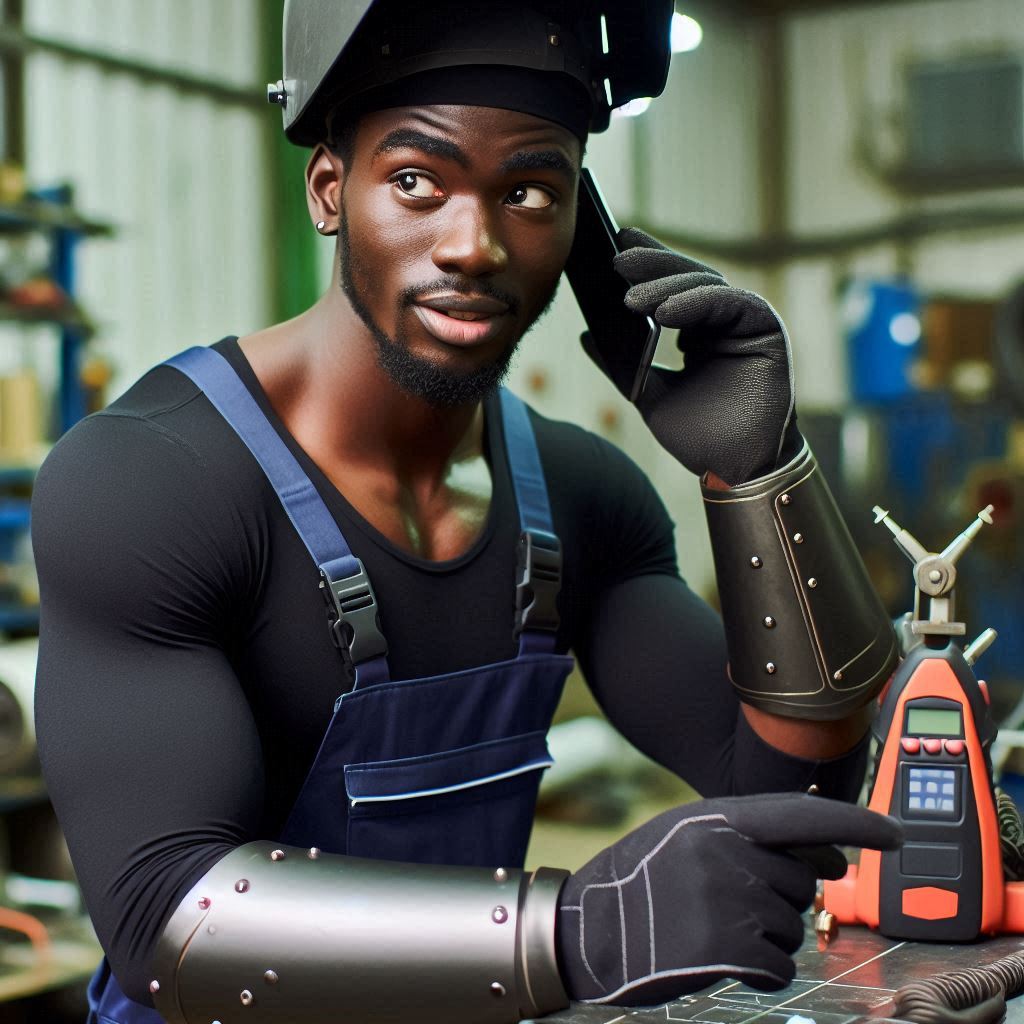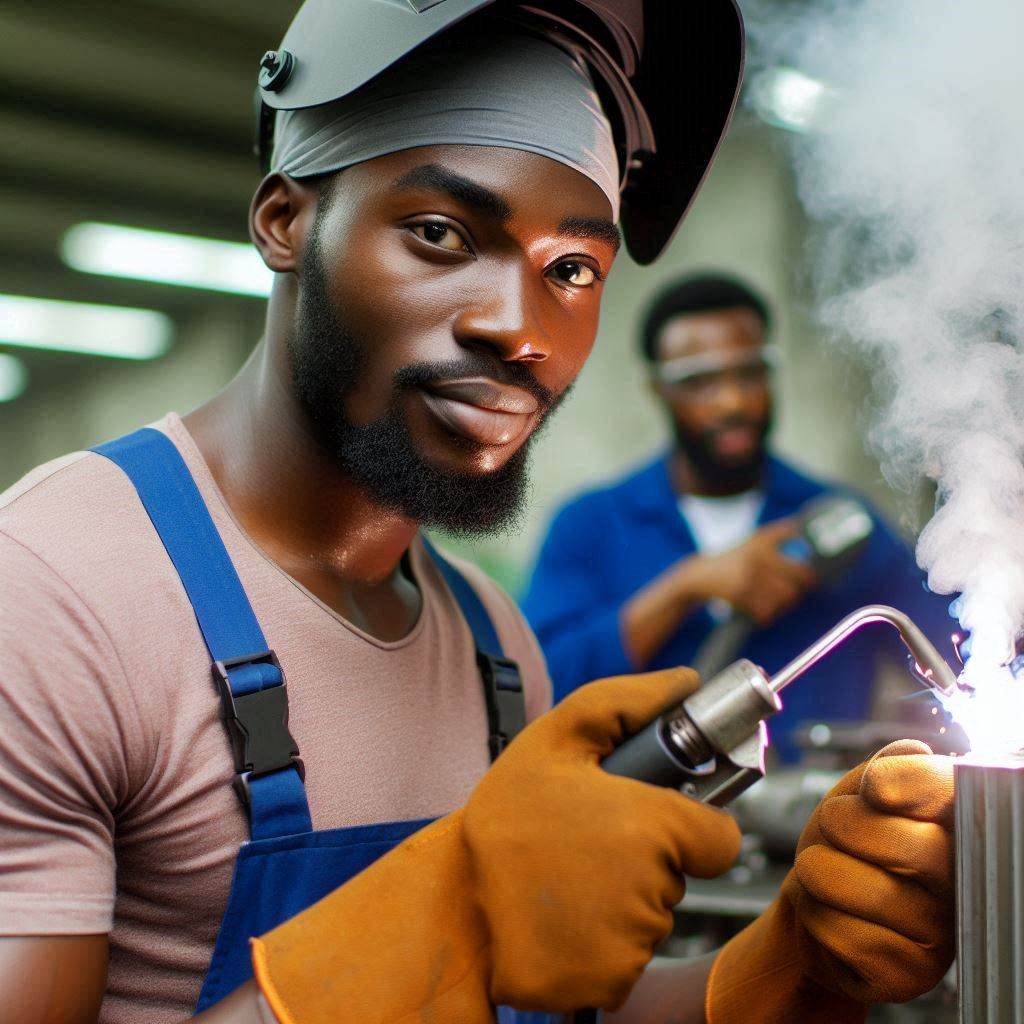Introduction
A Gateway to Creative Fabrication
Welding is a vital process in metalworking, essential for joining materials through heat and melting. Techniques like MIG (Metal Inert Gas), TIG (Tungsten Inert Gas), and stick welding offer versatility in applications from automotive repairs to artistic creations.
Understanding Welding Techniques
MIG welding utilizes a continuous wire feed as an electrode, ideal for fast production and thicker metals. TIG welding uses a non-consumable tungsten electrode to create precise and clean welds, suitable for thin materials and intricate designs.
Stick welding, or shielded metal arc welding (SMAW), involves a consumable electrode coated in flux, providing strong, stable welds in various environments.
Popularity of DIY Welding Projects
DIY welding projects appeal to beginners for several reasons. They offer hands-on experience, enabling enthusiasts to apply theoretical knowledge practically. This practical approach not only enhances welding skills but also fosters creativity in metal fabrication.
Beginners find satisfaction in crafting functional items like garden structures, furniture, or decorative pieces.
Moreover, DIY welding encourages exploration of safety practices and equipment handling, crucial for developing foundational skills. By engaging in diverse projects from basic repairs to intricate art pieces beginners gain confidence and proficiency in manipulating metal materials.
Benefits for Beginners
Embarking on DIY welding projects nurtures problem-solving abilities and promotes self-reliance in project execution. It provides a platform for experimenting with different welding techniques and materials, expanding skills progressively.
Each project serves as a learning opportunity, reinforcing understanding of welding principles and techniques.
Most Importantly, DIY welding projects serve as an accessible entry point for beginners into the world of metalworking. They not only facilitate skill development and technical proficiency but also cultivate a passion for creative expression through fabrication.
By embracing these projects, beginners embark on a journey of discovery, honing their craft and contributing to the growing community of welding enthusiasts.
Safety Measures
Emphasize the importance of safety gear such as gloves, goggles, and apron
Safety gear is crucial in welding to protect from heat, sparks, and harmful rays. Always wear welding gloves, goggles, and an apron. Gloves shield your hands from burns, cuts, and electrical shocks.
Goggles protect your eyes from intense light, flying debris, and ultraviolet radiation. An apron or protective clothing guards your body from sparks and molten metal.
Provide tips on how to create a safe working environment
Creating a safe working environment is essential for successful welding. Choose a well-ventilated area to prevent fume inhalation. Remove flammable materials like paper, wood, and chemicals from the workspace.
Ensure the welding area is dry to avoid electrical hazards. Keep a fire extinguisher nearby for emergencies. Use welding curtains or screens to protect others from welding arcs.
Mention the dangers of welding without proper safety precautions
Welding without proper safety precautions can lead to severe injuries or even death. Burns are common due to exposure to hot metal and sparks. Eye damage can occur from exposure to bright light or flying particles.
Inhalation of toxic fumes can cause respiratory issues or long-term health problems. Electrical shocks from faulty equipment can be fatal.
Include a brief overview of common safety hazards to avoid
Understanding common safety hazards helps prevent accidents. Avoid touching hot metal immediately after welding to prevent burns. Beware of flying sparks and debris that can cause eye injuries or ignite flammable materials.
Use proper ventilation to avoid inhaling harmful fumes. Ensure your welding equipment is in good condition to prevent electrical shocks.
Prioritizing safety in DIY welding projects is non-negotiable. Wearing the appropriate safety gear, such as gloves, goggles, and an apron, is essential to protect yourself from burns, eye injuries, and other hazards.
Creating a safe working environment, free of flammable materials and well-ventilated, significantly reduces the risk of accidents.
Ignoring proper safety precautions can result in severe injuries or even fatalities. The dangers of welding without adequate protection include burns, eye damage, toxic fume inhalation, and electrical shocks.
By understanding and avoiding common safety hazards, such as hot metal, flying sparks, and faulty equipment, you can ensure a safer welding experience.
Embrace the importance of safety in your welding projects. Investing in safety gear and creating a secure workspace not only protects you but also enhances your welding skills.
Stay informed about safety practices, and always prioritize your well-being while working on your DIY welding projects.
Read: Role of Agricultural Engineers in Nigerian Agriculture
Basic Welding Equipment
List essential welding tools for beginners
Starting with the right tools is crucial for successful welding projects. Beginners should have these essential tools: welding machine, welding helmet, welding gloves, welding jacket, wire brush, chipping hammer, and clamps. Each tool plays a specific role in ensuring quality welds and safety.
Explain the purpose and function of each tool
- Welding Machine: The core of any welding setup, it provides the electric current needed to join metals. Beginners often use MIG welders for their ease of use.
- Welding Helmet: Protects your eyes and face from harmful UV rays, sparks, and debris. Auto-darkening helmets adjust the lens shade for optimal protection and visibility.
- Welding Gloves: These heavy-duty gloves protect your hands from heat, sparks, and sharp metal edges. They are essential for handling hot materials safely.
- Welding Jacket: Made of flame-resistant material, a welding jacket shields your upper body from sparks, heat, and molten metal splatter.
- Wire Brush: Used to clean metal surfaces before and after welding. It helps remove rust, paint, and other contaminants that can affect weld quality.
- Chipping Hammer: Helps remove slag from the weld bead, ensuring a clean, smooth finish. The pointed and flat ends are designed for effective slag removal.
- Clamps: Essential for holding metal pieces together securely during welding. They ensure precision and stability, resulting in stronger welds.
Provide recommendations for affordable welding equipment
For beginners, affordability and quality are key. Here are some recommendations:
- MIG Welder: The Hobart Handler 140 MIG Welder is user-friendly and versatile, ideal for beginners tackling various projects. It’s reliable and reasonably priced.
- Auto-Darkening Helmet: The Antra AH6-260-0000 welding helmet offers excellent protection and comfort at an affordable price. Its auto-darkening feature adjusts quickly to light changes.
- Welding Gloves: Lincoln Electric Traditional Welding Gloves are durable, heat-resistant, and budget-friendly. They provide excellent protection for beginners.
- Welding Jacket: The Black Stallion FN9-30C welding jacket is cost-effective and made from flame-resistant cotton, ensuring safety without breaking the bank.
- Wire Brush and Chipping Hammer: A Forney 70501 wire brush and Estwing BIG BLUE welding/chipping hammer combo are affordable and durable, perfect for beginners.
The option of renting or purchasing equipment
Renting welding equipment is a practical option for beginners who want to try welding without a significant initial investment. Many local hardware stores and specialized shops offer rental services for welding machines, helmets, and other tools.
This allows you to test different equipment and find what suits you best before making a purchase.
Equipping yourself with essential welding tools is the first step to successful DIY projects. Understanding the purpose and function of each tool ensures you can use them effectively and safely.
Investing in affordable yet reliable equipment, or opting to rent, allows beginners to start welding without a hefty upfront cost. Whether you purchase or rent, having the right tools will set you up for success in your welding journey.
Read: Curriculum Overview of Agricultural Engineering Courses
Simple Welding Projects for Beginners
Present a variety of easy welding projects suitable for beginners
Beginners can start with simple welding projects that build confidence and skills. Here are three easy projects: a welded metal shelf, a garden trellis, and a metal picture frame.
Include step-by-step instructions for each project
Welded Metal Shelf
- Materials Needed: Steel angle iron, metal mesh, welding machine, welding helmet, gloves, clamps, wire brush, and chipping hammer.
- Cut the Steel: Measure and cut four pieces of angle iron for the frame and two for the supports.
- Assemble the Frame: Clamp the frame pieces together and tack weld the corners.
- Weld the Joints: Complete the welds on all corners, ensuring strong joints.
- Attach the Supports: Weld the support pieces to the frame, evenly spaced.
- Add the Mesh: Weld the metal mesh onto the frame to create the shelf surface.
- Clean the Welds: Use a wire brush and chipping hammer to clean the welds and remove slag.
- Finish: Paint or coat the shelf to protect against rust and add a polished look.
Garden Trellis
- Materials Needed: Steel rods, welding machine, welding helmet, gloves, clamps, wire brush, and chipping hammer.
- Cut the Rods: Measure and cut steel rods to the desired height and width.
- Assemble the Trellis: Arrange the rods in a grid pattern and clamp them in place.
- Tack Weld the Joints: Tack weld all intersecting points to secure the grid.
- Complete the Welds: Weld all joints fully, ensuring strong connections.
- Clean the Welds: Use a wire brush and chipping hammer to clean the welds.
- Anchor the Trellis: Weld or bolt feet or anchors to the bottom to secure the trellis in the ground.
- Finish: Apply a protective coating to prevent rust and enhance durability.
Metal Picture Frame
- Materials Needed: Flat steel bars, welding machine, welding helmet, gloves, clamps, wire brush, and chipping hammer.
- Cut the Steel Bars: Measure and cut steel bars to form the frame sides.
- Assemble the Frame: Clamp the bars into a rectangle and tack weld the corners.
- Weld the Joints: Complete the welds on all corners, ensuring a solid frame.
- Clean the Welds: Use a wire brush and chipping hammer to clean the welds.
- Add Backing and Hangers: Attach metal backing and picture hangers to the frame.
- Finish: Paint or coat the frame to match your décor and protect the metal.
Provide tips on how to troubleshoot common welding mistakes
Porosity: Ensure clean metal surfaces and adequate shielding gas to prevent gas pockets in welds. Clean the metal thoroughly before welding, removing rust, oil, and other contaminants. Check the gas flow rate and ensure there are no leaks in the gas supply.
Undercutting: Adjust welding speed and heat settings to avoid creating grooves along the weld edges. Move steadily along the weld seam and use the correct angle for the welding torch to ensure an even weld bead.
Cracks: Preheat thicker metals and ensure proper cooling to prevent cracking in the weld. Monitor the temperature during welding and control the cooling process by gradually reducing the heat.
Showcase the potential applications of each project
A welded metal shelf offers versatile storage solutions in garages, workshops, or even as industrial-style home décor. It provides a sturdy platform for tools, supplies, and decorative items.
The garden trellis supports climbing plants and enhances garden aesthetics. It can be used to create vertical gardens, support vines, or as a decorative element in landscaping.
A metal picture frame provides a durable, stylish way to display photos or artwork. It can be customized to fit any size and adds a unique industrial touch to home or office décor.
Starting with simple welding projects helps beginners build skills and confidence. Each project, from shelves to trellises, offers practical applications. Follow step-by-step instructions and use troubleshooting tips to perfect your welds.
These projects not only develop your welding abilities but also result in functional, creative items for everyday use. Embrace the learning process, and enjoy the satisfaction of creating with your own hands.
Read: Agricultural Engineering vs. Other Engineering Fields

Skill-building Techniques
Introduce techniques to improve welding skills
Improving welding skills requires practice, knowledge, and dedication. Beginners should focus on mastering techniques such as bead consistency, joint preparation, and heat control. Practicing these techniques will enhance overall welding quality.
Include information on practice exercises and drills
Straight Bead Practice
- Set Up: Secure a piece of scrap metal on your workbench.
- Draw a Line: Mark a straight line with chalk or a scribe on the metal.
- Weld the Line: Follow the line with a steady hand, focusing on maintaining a consistent bead width and penetration.
- Repeat: Practice multiple times, gradually increasing speed while maintaining quality.
T-Joint Practice
- Set Up: Position two metal pieces in a T-joint configuration and secure them with clamps.
- Tack Weld: Make small tack welds to hold the pieces together.
- Weld the Joint: Start welding from one end, keeping a consistent speed and heat.
- Inspect: Check for penetration and consistency, then repeat with new pieces.
Butt Joint Practice
- Set Up: Align two metal pieces edge-to-edge and clamp them.
- Tack Weld: Apply tack welds at intervals to secure the joint.
- Weld the Seam: Move steadily along the seam, ensuring even heat distribution.
- Evaluate: Inspect the weld for uniformity and strength.
The importance of patience and perseverance in mastering welding
Patience and perseverance are crucial in mastering welding. Beginners often face challenges, but consistent practice and learning from mistakes lead to improvement. Understand that welding is an art and a skill that requires time to perfect.
Resources for further learning and skill development
Online Courses
- Udemy: Offers various welding courses covering different techniques and levels of expertise.
- Coursera: Provides welding fundamentals and advanced courses from reputable institutions.
Books
- “Welding For Dummies” by Steven Robert Farnsworth: A comprehensive guide for beginners.
- “The Welding Handbook” by Richard Finch: Covers advanced techniques and best practices.
Workshops and Seminars
- Local Community Colleges: Often offer hands-on welding courses and workshops.
- Trade Schools: Provide specialized welding programs and certifications.
Online Communities
- WeldingWeb: A forum for welders to share tips, ask questions, and discuss projects.
- Reddit’s r/Welding: A community for welders to exchange advice and showcase their work.
Improving welding skills involves mastering fundamental techniques, engaging in practice exercises, and maintaining patience and perseverance.
Consistent practice with straight beads, T-joints, and butt joints builds confidence and proficiency. Utilizing resources such as online courses, books, workshops, and online communities further enhances learning and skill development.
Remember, welding is a craft that grows with dedication and experience. Embrace the journey, practice regularly, and seek out knowledge to become a skilled welder.
Read: How to Start a Career in Agricultural Engineering
Inspirational DIY Welding Projects
Highlighting success stories of beginners who have completed impressive welding projects
Many beginners have achieved impressive results with their welding projects. These success stories show what dedication and practice can achieve. One such beginner is John, who started welding as a hobby.
Initially, his welds were inconsistent and weak. However, with perseverance, he mastered the craft. John built a custom BBQ grill, which became the centerpiece of his backyard.
Maria is another inspiring beginner. She began welding small metal art pieces. Her first attempts were rough, but she didn’t give up.
With continuous practice, Maria improved her skills. She now creates intricate metal sculptures that she sells at local art fairs. Her journey from novice to entrepreneur is truly motivational.
Sam’s story also stands out. He wanted to create a garden trellis for his backyard. His first trellis was functional but unrefined. Sam practiced diligently, refining his techniques. His final trellis design is not only sturdy but also a beautiful addition to his garden.
Show before-and-after photos of beginner projects for inspiration
The Project 1: Custom BBQ Grill by John
- Before: John’s initial grill was a simple steel frame with uneven welds.
- After: John’s final BBQ grill is robust and stylish, with smooth, strong welds.
Project 2: Metal Art by Maria
- Before: Maria’s first metal art piece was a basic, rough heart sculpture.
- After: Maria now creates detailed and intricate sculptures that showcase her improved skills.
Project 3: Garden Trellis by Sam
- Before: Sam’s first trellis was wobbly and had inconsistent welds.
- After: Sam’s final trellis is a stable, beautifully welded structure supporting his climbing roses.
Include testimonials from beginners on the benefits of DIY welding projects
- John’s Testimonial: “Starting welding was tough, but every project taught me something new. Building my BBQ grill was incredibly rewarding.”
- Maria’s Testimonial: “I never imagined turning welding into a business. Each project improved my skills and boosted my confidence.”
- Sam’s Testimonial: “Creating my garden trellis was a game-changer. It showed me that with practice, I could create beautiful and functional items.”
Success stories from beginner welders highlight the transformative power of DIY projects. John’s BBQ grill, Maria’s metal art, and Sam’s garden trellis showcase what dedication and practice can achieve.
Before-and-after photos provide visual inspiration, illustrating significant progress.
Testimonials emphasize the benefits of welding projects, from gaining new skills to finding creative fulfillment. These stories remind us that every expert welder started as a beginner.
With patience and perseverance, anyone can achieve impressive results. Embrace the journey, and let these success stories inspire your own welding adventures. Whether you’re making functional items or creative art, the satisfaction of welding your own projects is unparalleled.
Conclusion
DIY welding projects offer beginners a valuable way to learn and develop welding skills. These projects build confidence and practical experience.
By starting small and practicing regularly, beginners can create impressive and functional items. Welding allows you to see tangible results from your efforts, which is incredibly rewarding.
I encourage readers to embark on their own welding projects. The journey may be challenging, but each project brings valuable lessons and satisfaction.
The more you practice, the better you will become. Remember, every expert welder started as a beginner.
Patience and perseverance are key to mastering welding. Finally, always prioritize safety in all your welding endeavors.
Proper safety gear and a safe working environment are essential. This not only protects you but also ensures that you can continue enjoying your welding projects without any setbacks.
In summary, DIY welding projects are an excellent way for beginners to learn and grow. Start your projects, stay persistent, and keep learning.
The journey of becoming a skilled welder is filled with creativity and satisfaction. Happy welding.




